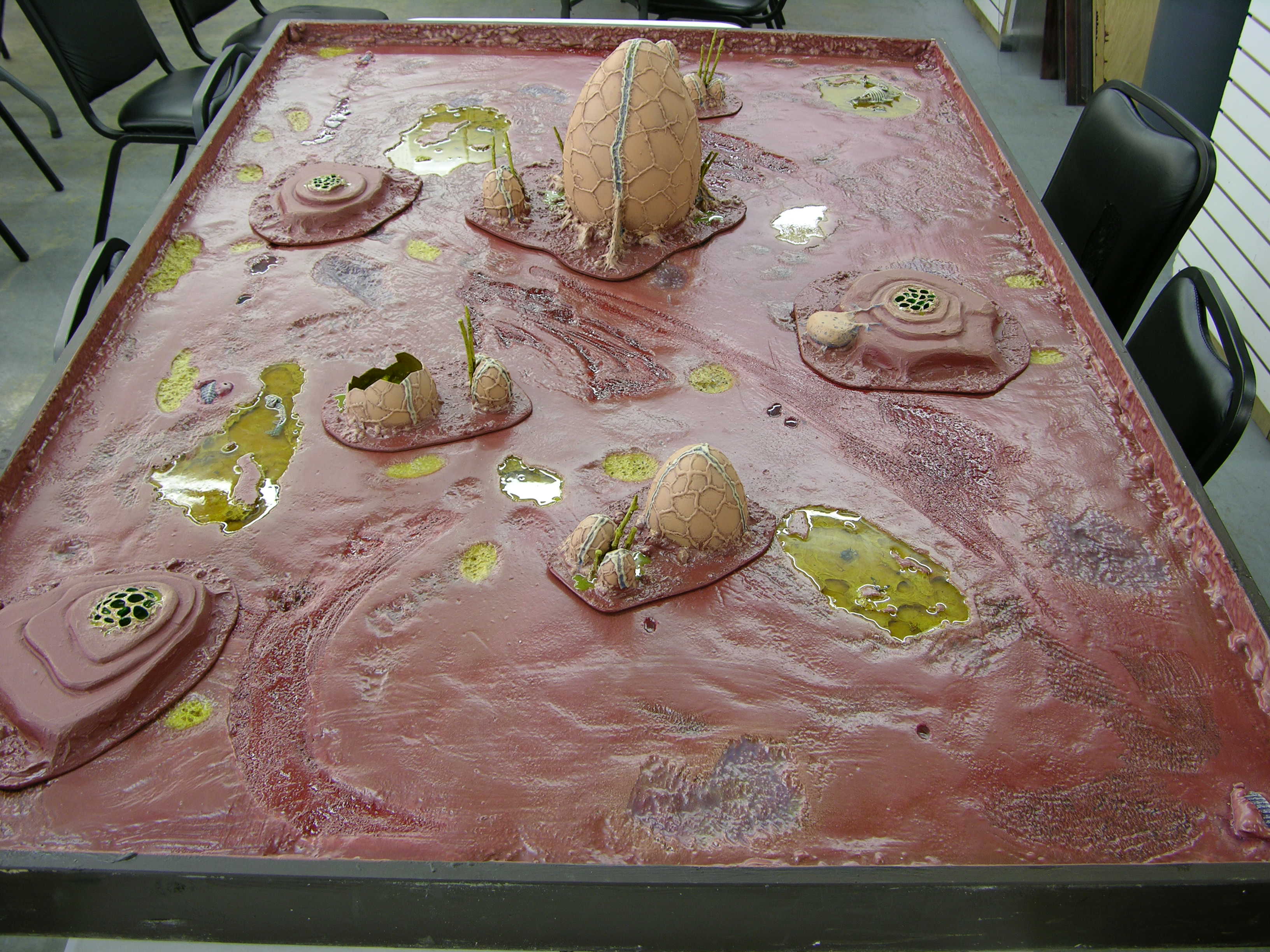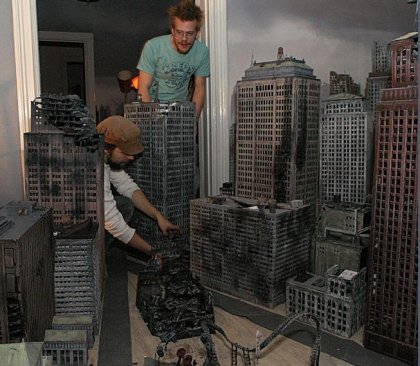Post by The Supreme Emissary on Apr 18, 2015 19:04:23 GMT -5
All hobbies require multiple spaces. SOme more considerable than others. Table gamers need space for crafting, storage space, then play space. The more involved the game and the more players involved, the more space you need.
For a lot of folks, abundance of space of any kind in their own home is not available. So we create clubs, go to shops, rent space, travel to conventions and so forth to find our ideal game spaces.
There are some wonderful basement showcases and gaming dens in people's homes, but even, a basement can only be so big. To support a community of players, something greater evolves.
SO, let's have a look at some war rooms. Some ideal battle bunkers and more importantly, the elements that go into making them, and finally, what LoreMasters players know or can do to find/make such a space.
.JPG)

Sign says World of Battle. I don't know anymore than that, except that it's snowing outside.
All this castle deco on the floor and walls is nifty.
Big campaign hex maps on the walls for different game campaigns. I love seeing stuff like that, but it needs big persistent events among the players to make use of them.
Vending Machines, everybody needs them.
Display cases, required for retailers and for showcases to display local work for sale or show. I like the idea of having cases that can store full display boards for members armies. Doubling as display and safe storage.
Short storage counters are a necessary fixture for selling unboxed items. Tall display cases can potentially capture the same storage spec for a fraction of the floor space, which takes on a greater premium all the time.
Shelving and open wall storage is critical for retail storage of boxed items, books and large items that don't require floor space. Vertical storage is critical for retail, but the more walls that are covered with shelves, the less space for banners, displays or fancy posters.
Windows complicate things even more. having a view is nice and all, but storage against glass and the effects of sunlight on prints and paints can be a very expensive problem to solve with UV blocking materials, or less so with blinds, curtains, screens, etc.
Tables are a universal component for all hobbies. For gamers like us there's a variety of table sizes between card games, board games or war games. Folding tables are perfect for versatile or cramped spaces but they're not stable or secure enough to support 6x4' crafting or display surfaces.
The tables in this pic are the best choices for permanent tables I've seen yet. Heavy metal 6x4' with lipped tops and deep storage space underneath. One big storage problem is finding a place to store various terrain pieces or boards not currently in use. Fetch closets and tubs are a common site and offer more security than storing them openly, but they require closet or shelf space that may be better used for something else. They also have the problem of increased chance of damage between packing, stacking, and shuffling.
Tables like these make for a good show, and if casters/skids are added then shifting the space as needed and combining tables becomes much much easier. On that note, a flat hard floor surface like concrete may be the best value. Adding rubberized padding like floor mats can help with standing stress or help make that lucky save with a dropped model.
They also force standing room, making stools ideal seating. They're no good for card players who pul up under the table, meaning either a split or shifting space is needed.
Gear storage is another element thats often under played but is easily addressed. That is, places to hang your coat, unpack your bag, store your tubs or cool your lunch. This is an element that most folks solve with the back of a chair or a corner of the floor.
-----
Some ideas that have come up in conversation for wargaming tables.
Desk space: empty areas at the end of a table, a small shelf or an unoccupied chair can be used to keep your books, dice, cards and other tools open and handy. This is a much better option than shuffling books around the middle of your war zone .
Dice Towers/Troughs: A dice tower is a simple but noisy construct used to roll your dice for you, keeping them secure. A trough or box is just a contained space for you to roll your dice without risking them flying off the table edge or smacking into your models. These can be covered with absorbing materials to reduce the noise of dice if you really need it.
Underlit table: A nifty but exotic idea using a massive light box table top and transparent blast markers and dry erase markers to draw lines, place markers and mark details without moving or shifting models. Precludes the usage of large terrain pieces.
Magetic Table: Another neato idea that allows for multi tiered terrain like buildings. The advantage is that any models that have magnetic bases and buildings that have magnetic levels can be lifted off each other like trays, without shifting of models. Magnetic paint, bases with glued magnets or bases cut from magnetic materials, building sections with pins and magnetic floors can allow the creation of more elaborate vertical play surfaces as well as improving the security of models on the table.
* Who was it again that made one of these? Was it Dustin?
-----
Describe your ideal game space for your favorite game and a space design you think would be best for LoreMasters members.
For a lot of folks, abundance of space of any kind in their own home is not available. So we create clubs, go to shops, rent space, travel to conventions and so forth to find our ideal game spaces.
There are some wonderful basement showcases and gaming dens in people's homes, but even, a basement can only be so big. To support a community of players, something greater evolves.
SO, let's have a look at some war rooms. Some ideal battle bunkers and more importantly, the elements that go into making them, and finally, what LoreMasters players know or can do to find/make such a space.
Sign says World of Battle. I don't know anymore than that, except that it's snowing outside.
All this castle deco on the floor and walls is nifty.
Big campaign hex maps on the walls for different game campaigns. I love seeing stuff like that, but it needs big persistent events among the players to make use of them.
Vending Machines, everybody needs them.
Display cases, required for retailers and for showcases to display local work for sale or show. I like the idea of having cases that can store full display boards for members armies. Doubling as display and safe storage.
Short storage counters are a necessary fixture for selling unboxed items. Tall display cases can potentially capture the same storage spec for a fraction of the floor space, which takes on a greater premium all the time.
Shelving and open wall storage is critical for retail storage of boxed items, books and large items that don't require floor space. Vertical storage is critical for retail, but the more walls that are covered with shelves, the less space for banners, displays or fancy posters.
Windows complicate things even more. having a view is nice and all, but storage against glass and the effects of sunlight on prints and paints can be a very expensive problem to solve with UV blocking materials, or less so with blinds, curtains, screens, etc.
Tables are a universal component for all hobbies. For gamers like us there's a variety of table sizes between card games, board games or war games. Folding tables are perfect for versatile or cramped spaces but they're not stable or secure enough to support 6x4' crafting or display surfaces.
The tables in this pic are the best choices for permanent tables I've seen yet. Heavy metal 6x4' with lipped tops and deep storage space underneath. One big storage problem is finding a place to store various terrain pieces or boards not currently in use. Fetch closets and tubs are a common site and offer more security than storing them openly, but they require closet or shelf space that may be better used for something else. They also have the problem of increased chance of damage between packing, stacking, and shuffling.
Tables like these make for a good show, and if casters/skids are added then shifting the space as needed and combining tables becomes much much easier. On that note, a flat hard floor surface like concrete may be the best value. Adding rubberized padding like floor mats can help with standing stress or help make that lucky save with a dropped model.
They also force standing room, making stools ideal seating. They're no good for card players who pul up under the table, meaning either a split or shifting space is needed.
Gear storage is another element thats often under played but is easily addressed. That is, places to hang your coat, unpack your bag, store your tubs or cool your lunch. This is an element that most folks solve with the back of a chair or a corner of the floor.
-----
Some ideas that have come up in conversation for wargaming tables.
Desk space: empty areas at the end of a table, a small shelf or an unoccupied chair can be used to keep your books, dice, cards and other tools open and handy. This is a much better option than shuffling books around the middle of your war zone .
Dice Towers/Troughs: A dice tower is a simple but noisy construct used to roll your dice for you, keeping them secure. A trough or box is just a contained space for you to roll your dice without risking them flying off the table edge or smacking into your models. These can be covered with absorbing materials to reduce the noise of dice if you really need it.
Underlit table: A nifty but exotic idea using a massive light box table top and transparent blast markers and dry erase markers to draw lines, place markers and mark details without moving or shifting models. Precludes the usage of large terrain pieces.
Magetic Table: Another neato idea that allows for multi tiered terrain like buildings. The advantage is that any models that have magnetic bases and buildings that have magnetic levels can be lifted off each other like trays, without shifting of models. Magnetic paint, bases with glued magnets or bases cut from magnetic materials, building sections with pins and magnetic floors can allow the creation of more elaborate vertical play surfaces as well as improving the security of models on the table.
* Who was it again that made one of these? Was it Dustin?
-----
Describe your ideal game space for your favorite game and a space design you think would be best for LoreMasters members.










